#Biodiversity Conference
Explore tagged Tumblr posts
Text
Excerpt from this story from Vox:
The United States is, by many measures, a global environmental leader, barring four years under former President Donald Trump. It has some of the strongest environmental laws in the world, such as the Endangered Species Act and the Clean Water Act. The country invests billions of dollars to fight climate change and wildlife declines. It also produces much of the world’s leading environmental research.
The current administration, led by President Joe Biden, prides itself on these environmental achievements.
That’s what makes this so surprising: The US is the only nation in the world, other than the Vatican, that hasn’t joined the most important global treaty to conserve nature. The treaty, known as the Convention on Biological Diversity (CBD), is designed to safeguard Earth’s life support systems, its animals, and ecosystems. And it’s not just some inconsequential agreement: It’s the best shot the world has at staving off ecological collapse.
This week, the Convention is meeting in Cali, Colombia, for an event known as COP16. Its members — governments from more than 190 countries — are negotiating plans for protecting forests and oceans, including how to raise around $700 billion for conservation. Critically, it’s the first meeting under the Convention since 2022, when its members agreed to a historic deal to stop biodiversity loss, known as the Global Biodiversity Framework. The framework includes 23 targets to reach by 2030, including conserving at least 30 percent of all land and ocean.
The US does have a presence at COP16. The country sent more than three dozen federal officials from the State Department, the White House Council on Environmental Quality (CEQ), and other divisions. And these representatives can influence the negotiations, two senior government officials told Vox.
As non-members to the Convention, that influence has a clear limit. The US can’t formally participate in negotiations or object to decisions at COP16. Those decisions could be administrative — such as where COP17 will take place — or relate to, say, what big drug companies should pay for using the DNA of wild organisms. The US is also noticeably absent from public discussions among environmental ministers that anchor COP16.
Dozens of countries signed the agreement then and there, including the UK, China, and Canada. But the US — then under President George H.W. Bush — was notably not one of them. And it largely came down to politics: It was an election year that pitted Bush against then-Arkansas Gov. Bill Clinton, and a number of senators in Bush’s party opposed signing the treaty, citing a wide range of concerns.
Among them was a fear that US biotech companies would have to share their intellectual property related to genetics with other countries. There were also widespread concerns that the US would be responsible for helping poorer nations — financially and otherwise — protect their natural resources and that the agreement would put more environmental regulations in place in the US. (At the time, there was already pushback among the timber industry and property rights groups on existing environmental laws, including the Endangered Species Act.)
7 notes
·
View notes
Text
At ESA2024 and just for fun I think I’m going to do a chain of some interesting talks for conservation/biodiversity stuff contributing to insect knowledge. Should be an interesting couple of days
8 notes
·
View notes
Text
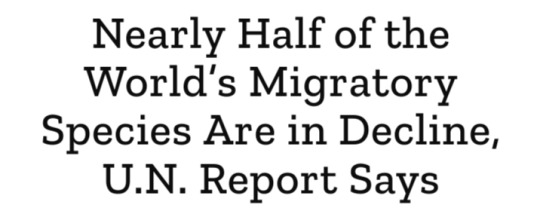
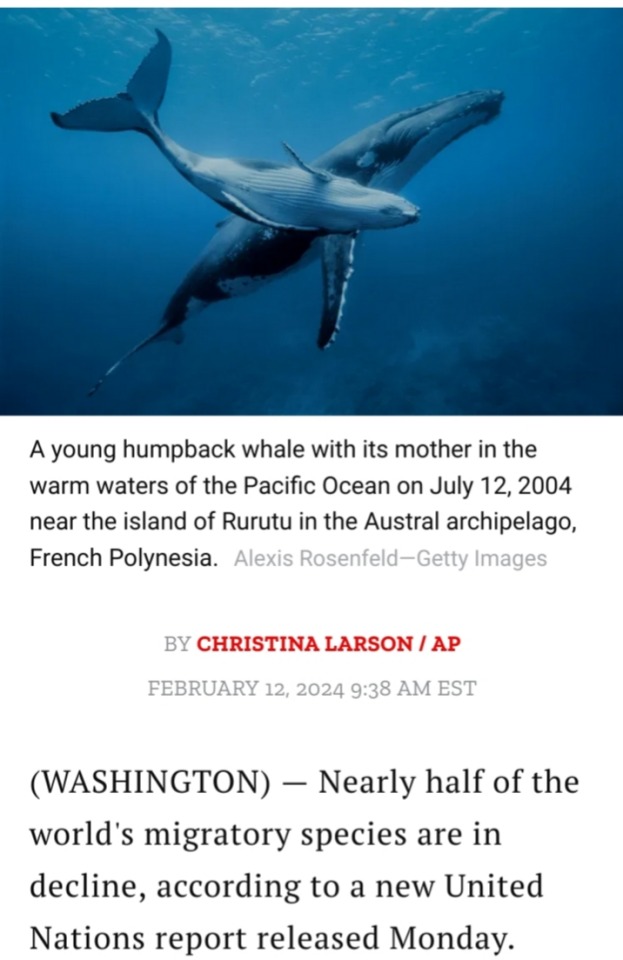
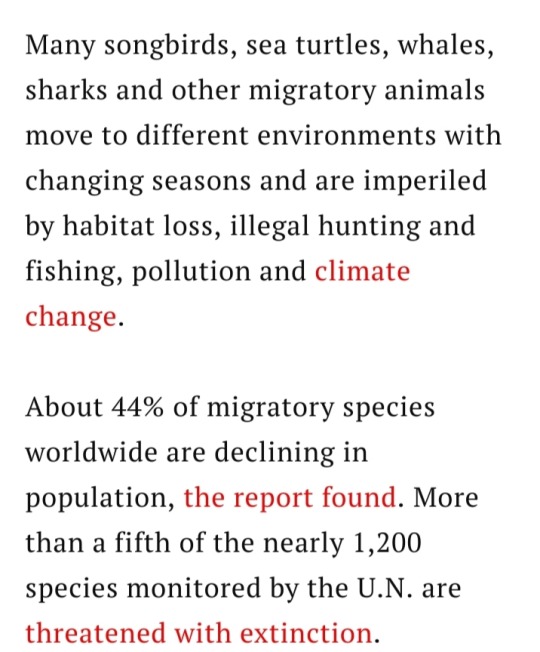
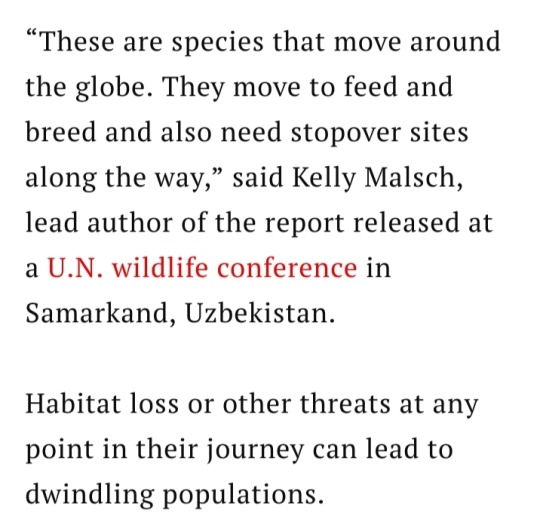
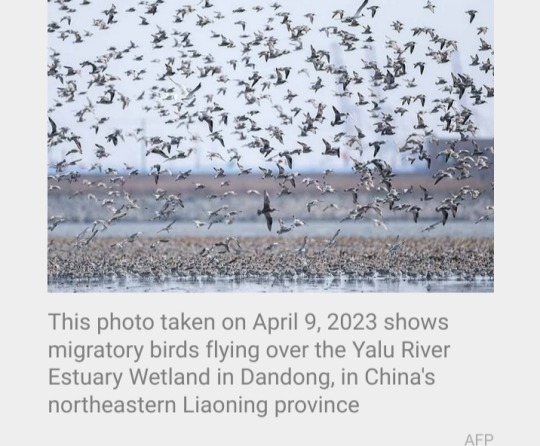



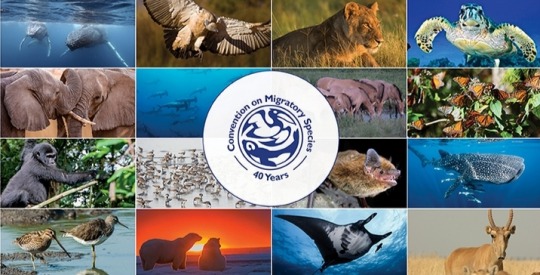

#United Nations#migratory species#wildlife conservation#climate change#habitat loss#pollution#illegal hunting#illegal fishing#International Union for Conservation of Nature's Red List#Wildlife Conservation Society#U.N. Biodiversity Conference#Amazon River#conservation#wildlife#UN Convention on the Conservation of Migratory Species of Wild Animals (CMS)
4 notes
·
View notes
Text
youtube
OCEAN WITH DAVID ATTENBOROUGH
Presenter: David Attenborough Year: 2025 Distributor: Altitude Films
"The ocean is fundamental to life on our planet and to our future. The ocean is an important source of the planet’s biodiversity and plays a vital role in the climate system and water cycle. The ocean provides a range of ecosystem services, supplies us with oxygen to breathe, contributes to food security, nutrition and decent jobs and livelihoods, acts as a sink and reservoir of greenhouse gases and protects biodiversity, provides a means for maritime transportation, including for global trade, forms an important part of our natural and cultural heritage and plays an essential role in sustainable development, a sustainable ocean-based economy and poverty eradication."- Political declaration of the 2022 United Nations ocean conference
"For the first time in human history, the world has come together with a common goal to protect nature. In December 2022, over 190 countries adopted the Kunming-Montreal Global Biodiversity Framework (also known as The Biodiversity Plan) – an international commitment to better protect the planet that sustains us all.
The framework includes 23 targets aimed at reversing habitat and species loss. Target 3, colloquially known as “30x30”, specifically calls for the effective protection and management of 30% of the world’s terrestrial, inland water, and coastal and marine areas by the year 2030.
Put simply, 30x30 is the biggest conservation commitment the world has ever seen. To date, more than 190 countries have committed to achieving the global goal."
Why we need 30x30: Protect 30% of land & water by 2030
"In 2025, the magnificent city of Nice, on the French Riviera, will host a global event of crucial importance: the United Nations Ocean Conference. From June 9 to 13(source), this major gathering will bring together leaders, experts, scientists and activists from around the world to address the pressing challenges facing our oceans. This conference promises to be a pivotal moment in the quest for sustainable solutions to protect our marine ecosystems.
The United Nations Ocean 2025 Conference has set ambitious goals to address the major issues facing the world's oceans. These goals include :
Protecting marine biodiversity : The conference will focus on strengthening measures to protect endangered marine species and promote strategies to preserve fragile marine ecosystems.
Combating marine pollution: Faced with the growing threat of plastic pollution, oil spills and other forms of pollution, participants will explore innovative solutions to reduce the impact of human activity on the oceans.
Climate change and ocean acidification: The conference will address the complex links between climate change and ocean impacts, including acidification, exploring mitigation and adaptation measures.
Sustainable development of maritime activities: Discussions will focus on promoting sustainable practices in key sectors such as fishing, aquaculture, maritime transport and coastal tourism, in order to maintain the ecological balance of the oceans."
UN 2025 Ocean Conference | Department of Economic and Social Affairs
#david attenborough#conservation#ocean#oceans#marine life#marine conservation#United Nations#biodiversity#UN 2025 Ocean Conference#UN#UN Ocean Conference#30x30#Youtube
0 notes
Text
What has been agreed?
‘Agreeing to agree’ on a new fund
Many developing countries demanded a new bank account to distribute nature finance. They argue that the current fund – which sits within the Global Environment Facility (GEF) – is too burdensome to access and is controlled by wealthy nations. This was the subject of the most tense negotiations.
“Agreeing to agree is maybe not sexy,” said Bernadette Fischler Hooper, global advocacy lead at WWF, “but it is a big achievement.” She added: “We’re going to live to fight another day. That is exactly what that is about.”
Countries will agree what to do on the new fund in 2028. In the meantime, all options are on the table – it could be a new fund, or an existing fund that has been made more palatable.
Roadmap for producing cash
The headline figure agreed on by countries at Cop15 in 2022 was to generate $200bn a year in nature finance. Developed nations committed to delivering $20bn in international biodiversity finance by 2025 – a deadline that has not yet been met. Negotiators agreed a roadmap to raising the money, which includes looking for new forms of finance as well as a push for development banks to increase spending on biodiversity.
For the first time there will be an “international dialogue” between ministers of finance and environment (as happens within the UN climate framework) which will make sure that finance for biodiversity is not siloed within environmental ministries. Brian O’Donnell, director of Campaign for Nature, described it as a “highlight of this deal”.
Monitoring progress
Cop17 in 2026 will be about measuring how countries are doing relative to their targets. In Rome they signed off what indicators they will use to submit their national reports. “The monitoring framework will allow us to do the accountability process at the next Cop,” said Chandler.
Launch of Cali fund
The Cali fund is a way to distribute money from companies who benefit from nature’s genetics. The fund was launched with nothing pledged, but the UN said commitments were coming “very soon”. According to the agreement, companies that met two of three criteria – sales of more than $50m (£39m), profits of more than $5m, and $20m in total assets – would need to contribute 1% of profits or 0.1% of their revenue to the fund.
The deal is voluntary and governments will need to introduce the rules domestically for it to have teeth.
0 notes
Text
Countries Meet in Rome for Second COP16 Biodiversity Conference
People supporting biodiversity rally at the Climate Pride street parade in Rome, Italy on Nov. 16, 2024. Andrea Ronchini / NurPhoto via Getty Images Why you can trust us Founded in 2005 as an Ohio-based environmental newspaper, EcoWatch is a digital platform dedicated to publishing quality, science-based content on environmental issues, causes, and solutions. Countries are meeting in Rome this…

View On WordPress
0 notes
Text









The best of The Great Vampire Debate
#The biodiversity of this hellsite#TIL#Its like a little conference in the tags and comments#and this one is actually fun
23K notes
·
View notes
Text
Advancing urban tree monitoring with AI-powered digital twins
New Post has been published on https://thedigitalinsider.com/advancing-urban-tree-monitoring-with-ai-powered-digital-twins/
Advancing urban tree monitoring with AI-powered digital twins


The Irish philosopher George Berkely, best known for his theory of immaterialism, once famously mused, “If a tree falls in a forest and no one is around to hear it, does it make a sound?”
What about AI-generated trees? They probably wouldn’t make a sound, but they will be critical nonetheless for applications such as adaptation of urban flora to climate change. To that end, the novel “Tree-D Fusion” system developed by researchers at the MIT Computer Science and Artificial Intelligence Laboratory (CSAIL), Google, and Purdue University merges AI and tree-growth models with Google’s Auto Arborist data to create accurate 3D models of existing urban trees. The project has produced the first-ever large-scale database of 600,000 environmentally aware, simulation-ready tree models across North America.
“We’re bridging decades of forestry science with modern AI capabilities,” says Sara Beery, MIT electrical engineering and computer science (EECS) assistant professor, MIT CSAIL principal investigator, and a co-author on a new paper about Tree-D Fusion. “This allows us to not just identify trees in cities, but to predict how they’ll grow and impact their surroundings over time. We’re not ignoring the past 30 years of work in understanding how to build these 3D synthetic models; instead, we’re using AI to make this existing knowledge more useful across a broader set of individual trees in cities around North America, and eventually the globe.”
Tree-D Fusion builds on previous urban forest monitoring efforts that used Google Street View data, but branches it forward by generating complete 3D models from single images. While earlier attempts at tree modeling were limited to specific neighborhoods, or struggled with accuracy at scale, Tree-D Fusion can create detailed models that include typically hidden features, such as the back side of trees that aren’t visible in street-view photos.
The technology’s practical applications extend far beyond mere observation. City planners could use Tree-D Fusion to one day peer into the future, anticipating where growing branches might tangle with power lines, or identifying neighborhoods where strategic tree placement could maximize cooling effects and air quality improvements. These predictive capabilities, the team says, could change urban forest management from reactive maintenance to proactive planning.
A tree grows in Brooklyn (and many other places)
The researchers took a hybrid approach to their method, using deep learning to create a 3D envelope of each tree’s shape, then using traditional procedural models to simulate realistic branch and leaf patterns based on the tree’s genus. This combo helped the model predict how trees would grow under different environmental conditions and climate scenarios, such as different possible local temperatures and varying access to groundwater.
Now, as cities worldwide grapple with rising temperatures, this research offers a new window into the future of urban forests. In a collaboration with MIT’s Senseable City Lab, the Purdue University and Google team is embarking on a global study that re-imagines trees as living climate shields. Their digital modeling system captures the intricate dance of shade patterns throughout the seasons, revealing how strategic urban forestry could hopefully change sweltering city blocks into more naturally cooled neighborhoods.
“Every time a street mapping vehicle passes through a city now, we’re not just taking snapshots — we’re watching these urban forests evolve in real-time,” says Beery. “This continuous monitoring creates a living digital forest that mirrors its physical counterpart, offering cities a powerful lens to observe how environmental stresses shape tree health and growth patterns across their urban landscape.”
AI-based tree modeling has emerged as an ally in the quest for environmental justice: By mapping urban tree canopy in unprecedented detail, a sister project from the Google AI for Nature team has helped uncover disparities in green space access across different socioeconomic areas. “We’re not just studying urban forests — we’re trying to cultivate more equity,” says Beery. The team is now working closely with ecologists and tree health experts to refine these models, ensuring that as cities expand their green canopies, the benefits branch out to all residents equally.
It’s a breeze
While Tree-D fusion marks some major “growth” in the field, trees can be uniquely challenging for computer vision systems. Unlike the rigid structures of buildings or vehicles that current 3D modeling techniques handle well, trees are nature’s shape-shifters — swaying in the wind, interweaving branches with neighbors, and constantly changing their form as they grow. The Tree-D fusion models are “simulation-ready” in that they can estimate the shape of the trees in the future, depending on the environmental conditions.
“What makes this work exciting is how it pushes us to rethink fundamental assumptions in computer vision,” says Beery. “While 3D scene understanding techniques like photogrammetry or NeRF [neural radiance fields] excel at capturing static objects, trees demand new approaches that can account for their dynamic nature, where even a gentle breeze can dramatically alter their structure from moment to moment.”
The team’s approach of creating rough structural envelopes that approximate each tree’s form has proven remarkably effective, but certain issues remain unsolved. Perhaps the most vexing is the “entangled tree problem;” when neighboring trees grow into each other, their intertwined branches create a puzzle that no current AI system can fully unravel.
The scientists see their dataset as a springboard for future innovations in computer vision, and they’re already exploring applications beyond street view imagery, looking to extend their approach to platforms like iNaturalist and wildlife camera traps.
“This marks just the beginning for Tree-D Fusion,” says Jae Joong Lee, a Purdue University PhD student who developed, implemented and deployed the Tree-D-Fusion algorithm. “Together with my collaborators, I envision expanding the platform’s capabilities to a planetary scale. Our goal is to use AI-driven insights in service of natural ecosystems — supporting biodiversity, promoting global sustainability, and ultimately, benefiting the health of our entire planet.”
Beery and Lee’s co-authors are Jonathan Huang, Scaled Foundations head of AI (formerly of Google); and four others from Purdue University: PhD students Jae Joong Lee and Bosheng Li, Professor and Dean’s Chair of Remote Sensing Songlin Fei, Assistant Professor Raymond Yeh, and Professor and Associate Head of Computer Science Bedrich Benes. Their work is based on efforts supported by the United States Department of Agriculture’s (USDA) Natural Resources Conservation Service and is directly supported by the USDA’s National Institute of Food and Agriculture. The researchers presented their findings at the European Conference on Computer Vision this month.
#000#3d#3D modeling#agriculture#ai#AI-powered#air#air quality#algorithm#Algorithms#America#applications#approach#artificial#Artificial Intelligence#author#biodiversity#buildings#change#cities#climate#climate change#Collaboration#computer#Computer modeling#Computer Science#Computer Science and Artificial Intelligence Laboratory (CSAIL)#Computer science and technology#Computer vision#conference
0 notes
Text
Software Platform for Analise of Data in The Field of Waste Management_ Crimson Publishers
Software Platform for Analise of Data in The Field of Waste Management by Hiroshi Bando In Integrative Journal of Conference Proceedings
Abstract
This system will create activity in the waste market, which will involve processors. For this purpose, the research of thermal conductivity of RDF-raw materials of waste landfills in the laboratory of quality control of new functional materials GUAP and programming in Java Script virtual platform ECO 365.The global perspective of the project is the consolidation of the laboratory of new composite materials GUAP to create a waste processing Center with the main focus on research in the field of production and sale of biogas. Demand in the market is large. The used technologies of analytical and measuring instruments and programs of three-dimensional equipment will allow to apply in parallel with the analysis of raw materials the possibility of developing equipment to produce by-products from waste with their subsequent certification. The main goal pursued when working in JavaScript [1,2] is to get closer to a successfully working prototype in the Russian food market the agro 24 platform, which implements the principle of a catalyst for the movement of perishable products. ECO-365 program-analogue in the field of storage, processing and sale of waste [1-3].
For more open access journals in Crimson Publishers please click on: https://crimsonpublishers.com/icp/
Read more articles in our site: https://crimsonpublishers.com/icp/index.php
#crimson icp#conference proceedings#integrative medicine (im)#conferences#proceedings#biodiversity#integrative health#artificial intelligence
0 notes
Text
A Green Odyssey: Walking in the Footsteps of St. Barbe Baker
In the heart of Saskatchewan, a passionate group is rallying support for an extraordinary journey that transcends borders and echoes the environmental legacy of one of history’s unsung heroes. Friends of the Saskatoon Afforestation Areas Inc., a non-profit environmental charity, is paving the way for their Vice Chairman to attend the United Nations Environment Assembly (UNEA-6) in Nairobi, Kenya.…

View On WordPress
#action#Africa#alliances#assembly#awareness#biodiversity#brighter future#change#climate change#collaboration#commitment#community#conference#conservation#contribution#corporation#dialogue#donation#empowerment#environmental advocacy#environmental advocates#environmental champion#environmental issues#environmental passion#environmental stewardship#footsteps#Friends of the Saskatoon Afforestation Areas#fundraiser#George Genereux Urban REgional Park#Global Impact
0 notes
Text
While COP29 is the more well-known international conference on climate change, COP16.2 concluded in February and focused on stopping biodiversity loss.
After stalled negotiations at the COP16.1 conference last year, there was significant progress at COP16.2--including countries pledging to contribute $200 billion per year to protect biodiversity and ecosystems.
This conference also saw the creation of the Cali Fund, which will receive a portion of revenue from companies that use genetic data from the natural world for commercial purposes. One stipulation of the Cali Fund is that at least 50% of its financial resources must go towards indigenous and local communities.
#COP16#biodiversity#good news#hope#wildlife#endangered species#climate change#environment#ecology#habitat#habitat conservation#extinction#progress#hopepunk
283 notes
·
View notes
Text
A Major Push to Protect Nature Is Happening Now. (New York Times)
Excerpt from this New York Times story:
On the agenda is life on earth, in all its forms and diversity. The big question is how far nations will go to stop the disastrous declines underway.
Representatives from more than 175 countries are gathering to negotiate answers, starting on Monday in Cali, Colombia, at what is expected to be the largest United Nations biodiversity conference in history.
How the talks unfold over the next two weeks will help determine, for better or worse, the planet’s future. Biodiversity is declining faster than at any time in human history, an intergovernmental panel of scientists found in 2019. It estimated that a million species were in danger of extinction. Even many common species are in decline. Bird populations in the United States and Canada, for example, are down almost 30 percent since 1970, with widespread losses among some of the most frequently seen species.
The biggest driver of declines in biodiversity on land is habitat loss, mainly when land is taken for agriculture, the panel found. In the ocean, it’s overfishing. Climate change plays an ever-growing role, and the two crises are intertwined.
Such drastic losses of biodiversity threaten human well-being, scientists warn. Forests filled with birdsong also stash away planet-warming carbon, filter water and create rain. Healthy rivers and oceans run with fish that people need for food. Insects nourish soil and pollinate plants, birds and mammals disperse seeds, plants turn sunshine into food for the rest of us.
“When we destroy biodiversity, we are destroying the very links that help the system to reproduce life,” said Susana Muhamad, Colombia’s environment minister, who will be presiding over the conference. “What is at stake is actually another wave of extinction, which could be the sixth general extinction on Earth.” The last one wiped out the dinosaurs.
United Nations negotiations — this session is known as COP16, meaning it is the 16th Conference of the Parties to the Convention on Biological Diversity — can sometimes feel absurdly bureaucratic and frustratingly toothless. But, participants say, global cooperation is fundamental to tackling issues like biodiversity loss and climate change, sprawling environmental crises that transcend national boundaries. (The next United Nations climate conference, the 29th in that series of COPs, starts in Baku, Azerbaijan, next month.)
3 notes
·
View notes
Text
Prime Minister Justin Trudeau has announced a $270-million agreement for jobs and conservation projects in the Qikiqtani region of Nunavut. At a news conference Thursday in Montreal, Trudeau said the deal includes $200 million from the federal government and $70 million pledged by donors in Canada and elsewhere. The investment is projected to attract $318 million over 15 years to the region, which is home to about 20,000 people in 13 communities. "When we invest to protect (and) safeguard biodiversity, we protect those who protect us, our environment and our livelihoods," Trudeau told reporters.
Continue Reading
Tagging: @newsfromstolenland
#indigenous#first nations#indigenous land#environment#nunavut#cdnpoli#canadian politics#canadian news#canada
219 notes
·
View notes
Text
Amazon forest felled to build road for climate summit
A new four-lane highway cutting through tens of thousands of acres of protected Amazon rainforest is being built for the COP30 climate summit in the Brazilian city of Belém.
It aims to ease traffic to the city, which will host more than 50,000 people - including world leaders - at the conference in November.
The state government touts the highway's "sustainable" credentials, but some locals and conservationists are outraged at the environmental impact.
The Amazon plays a vital role in absorbing carbon for the world and providing biodiversity, and many say this deforestation contradicts the very purpose of a climate summit.
Along the partially built road, lush rainforest towers on either side - a reminder of what was once there. Logs are piled high in the cleared land which stretches more than 13km (8 miles) through the rainforest into Belém.
Diggers and machines carve through the forest floor, paving over wetland to surface the road which will cut through a protected area.
A new four-lane highway cutting through tens of thousands of acres of protected Amazon rainforest is being built for the COP30 climate summit in the Brazilian city of Belém.
It aims to ease traffic to the city, which will host more than 50,000 people - including world leaders - at the conference in November.
The state government touts the highway's "sustainable" credentials, but some locals and conservationists are outraged at the environmental impact.
The Amazon plays a vital role in absorbing carbon for the world and providing biodiversity, and many say this deforestation contradicts the very purpose of a climate summit.
Along the partially built road, lush rainforest towers on either side - a reminder of what was once there. Logs are piled high in the cleared land which stretches more than 13km (8 miles) through the rainforest into Belém.
Diggers and machines carve through the forest floor, paving over wetland to surface the road which will cut through a protected area.

98 notes
·
View notes
Text
Recently, I attended a conference where people referred to it as the ‘triple planetary crisis’ (climate change, biodiversity loss and plastic/waste pollution) and honestly I think it’s a game changer, shorter to say that ‘climate and ecological crisis’, leaves out a lot of the words that switch people off (warming, extinction, etc) and yet conveys urgency and a sense of universal responsibility. What do you guys think?
#solarpunk#hopepunk#environmentalism#social justice#community#climate justice#bright future#terminology#triple planetary crisis
628 notes
·
View notes
Text
Brazil to highlight climate success, struggles by hosting 2025 COP in the Amazon

Brazil will host the 2025 UN Conference of Parties (COP) climate summit in the Amazon rainforest and focus on “challenges” and “success stories.” Analysts can find both in actions by the country and JBS SA, one of the largest meat processing companies in the world.
Brazil leads BRICS economies in curbing CO2 emissions but still lags behind projections needed to avoid global warming. It committed to reducing emissions by 59% to 67% by 2035 and is one of the first nations to provide an updated Nationally Determined Contribution to the Paris Agreement.
The nation is currently a global leader in renewable energy but will need to invest significantly more to achieve 2025 net-zero goal s. Hydropower accounts for 110 GW of its total 236 GW in installed capacity, while solar has reached 48 GW and wind 28 GW.
Brazil’s reduction targets were increased at the COP29 summit in Azerbaijan in late November. This came as part of a climate finance deal calling on developed nations to provide $300 billion per year in climate financing to the developing world. Brazil’s biodiversity and broader aims to fight deforestation make it a top global funding priority.
Continue reading.
#brazilian politics#brazil#politics#environmentalism#cop30#image description in alt#mod nise da silveira
45 notes
·
View notes